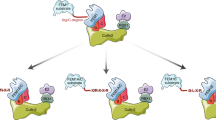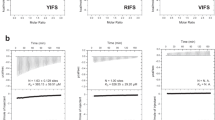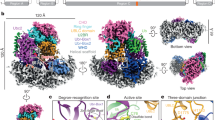Abstract
Proteome integrity depends on the ubiquitin–proteasome system to degrade unwanted or abnormal proteins. In addition to the N-degrons, C-terminal residues of proteins can also serve as degradation signals (C-degrons) that are recognized by specific cullin-RING ubiquitin ligases (CRLs) for proteasomal degradation. FEM1C is a CRL2 substrate receptor that targets the C-terminal arginine degron (Arg/C-degron), but the molecular mechanism of substrate recognition remains largely elusive. Here, we present crystal structures of FEM1C in complex with Arg/C-degron and show that FEM1C utilizes a semi-open binding pocket to capture the C-terminal arginine and that the extreme C-terminal arginine is the major structural determinant in recognition by FEM1C. Together with biochemical and mutagenesis studies, we provide a framework for understanding molecular recognition of the Arg/C-degron by the FEM family of proteins.

This is a preview of subscription content, access via your institution
Access options
Access Nature and 54 other Nature Portfolio journals
Get Nature+, our best-value online-access subscription
$29.99 / 30 days
cancel any time
Subscribe to this journal
Receive 12 print issues and online access
$259.00 per year
only $21.58 per issue
Buy this article
- Purchase on Springer Link
- Instant access to full article PDF
Prices may be subject to local taxes which are calculated during checkout




Similar content being viewed by others
Data availability
The atomic coordinates and structure factors of FEM1C and the FEM1C–peptide complex have been deposited in the Protein Data Bank (https://www.rcsb.org/) with the accession codes 6XKC and 7JYA, respectively. Source data are provided with this paper.
References
Hershko, A. & Ciechanover, A. The ubiquitin system. Annu. Rev. Biochem. 67, 425–479 (1998).
Balchin, D., Hayer-Hartl, M. & Hartl, F. U. In vivo aspects of protein folding and quality control. Science 353, aac4354 (2016).
Johnson, B. M. & DeBose-Boyd, R. A. Underlying mechanisms for sterol-induced ubiquitination and ER-associated degradation of HMG CoA reductase. Semin. Cell Dev. Biol. 81, 121–128 (2018).
Sontag, E. M., Samant, R. S. & Frydman, J. Mechanisms and functions of spatial protein quality control. Annu. Rev. Biochem. 86, 97–122 (2017).
Pickart, C. M. Mechanisms underlying ubiquitination. Annu. Rev. Biochem. 70, 503–533 (2001).
Finley, D. Recognition and processing of ubiquitin–protein conjugates by the proteasome. Annu. Rev. Biochem. 78, 477–513 (2009).
Varshavsky, A. Naming a targeting signal. Cell 64, 13–15 (1991).
Lucas, X. & Ciulli, A. Recognition of substrate degrons by E3 ubiquitin ligases and modulation by small-molecule mimicry strategies. Curr. Opin. Struct. Biol. 44, 101–110 (2017).
Bachmair, A., Finley, D. & Varshavsky, A. In vivo half-life of a protein is a function of its amino-terminal residue. Science 234, 179–186 (1986).
Varshavsky, A. The N-end rule pathway and regulation by proteolysis. Protein Sci. 20, 1298–1345 (2011).
Varshavsky, A. N-degron and C-degron pathways of protein degradation. Proc. Natl Acad. Sci. USA 116, 358–366 (2019).
Hwang, C. S., Shemorry, A. & Varshavsky, A. N-terminal acetylation of cellular proteins creates specific degradation signals. Science 327, 973–977 (2010).
Chen, S. J., Wu, X., Wadas, B., Oh, J. H. & Varshavsky, A. An N-end rule pathway that recognizes proline and destroys gluconeogenic enzymes. Science 355, eaal3655 (2017).
Timms, R. T. et al. A glycine-specific N-degron pathway mediates the quality control of protein N-myristoylation. Science https://doi.org/10.1126/science.aaw4912 (2019).
Kim, J. M. et al. Formyl-methionine as an N-degron of a eukaryotic N-end rule pathway. Science https://doi.org/10.1126/science.aat0174 (2018).
Dissmeyer, N. Conditional protein function via N-degron pathway-mediated proteostasis in stress physiology. Annu. Rev. Plant Biol. https://doi.org/10.1146/annurev-arplant-050718-095937 (2019).
Liu, Y., Liu, C., Dong, W. & Li, W. Physiological functions and clinical implications of the N-end rule pathway. Front. Med. 10, 258–270 (2016).
Choi, W. S. et al. Structural basis for the recognition of N-end rule substrates by the UBR box of ubiquitin ligases. Nat. Struct. Mol. Biol. 17, 1175–1181 (2010).
Matta-Camacho, E., Kozlov, G., Li, F. F. & Gehring, K. Structural basis of substrate recognition and specificity in the N-end rule pathway. Nat. Struct. Mol. Biol. 17, 1182–1187 (2010).
Kwon, D. H. et al. Insights into degradation mechanism of N-end rule substrates by p62/SQSTM1 autophagy adapter. Nat. Commun. 9, 3291 (2018).
Zhang, Y. et al. ZZ-dependent regulation of p62/SQSTM1 in autophagy. Nat. Commun. 9, 4373 (2018).
Dong, C. et al. Molecular basis of GID4-mediated recognition of degrons for the Pro/N-end rule pathway. Nat. Chem. Biol. 14, 466–473 (2018).
Dong, C. et al. Recognition of nonproline N-terminal residues by the Pro/N-degron pathway. Proc. Natl Acad. Sci. USA https://doi.org/10.1073/pnas.2007085117 (2020).
Koren, I. et al. The eukaryotic proteome is shaped by E3 ubiquitin ligases targeting C-terminal degrons. Cell 173, 1622–1635 (2018).
Lin, H. C. et al. C-terminal end-directed protein elimination by CRL2 ubiquitin ligases. Mol. Cell 70, 602–613 (2018).
Chatr-Aryamontri, A., van der Sloot, A. & Tyers, M. At long last, a C-terminal bookend for the ubiquitin code. Mol. Cell 70, 568–571 (2018).
Timms, R. T. & Koren, I. Tying up loose ends: the N-degron and C-degron pathways of protein degradation. Biochem. Soc. Trans. https://doi.org/10.1042/BST20191094 (2020).
Kamura, T. et al. VHL-box and SOCS-box domains determine binding specificity for Cul2–Rbx1 and Cul5–Rbx2 modules of ubiquitin ligases. Genes Dev. 18, 3055–3065 (2004).
Mahrour, N. et al. Characterization of cullin-box sequences that direct recruitment of Cul2–Rbx1 and Cul5–Rbx2 modules to elongin BC-based ubiquitin ligases. J. Biol. Chem. 283, 8005–8013 (2008).
Dankert, J. F., Pagan, J. K., Starostina, N. G., Kipreos, E. T. & Pagano, M. FEM1 proteins are ancient regulators of SLBP degradation. Cell Cycle 16, 556–564 (2017).
Starostina, N. G. et al. A CUL-2 ubiquitin ligase containing three FEM proteins degrades TRA-1 to regulate C. elegans sex determination. Dev. Cell 13, 127–139 (2007).
Chan, S. L., Yee, K. S., Tan, K. M. & Yu, V. C. The Caenorhabditis elegans sex determination protein FEM-1 is a CED-3 substrate that associates with CED-4 and mediates apoptosis in mammalian cells. J. Biol. Chem. 275, 17925–17928 (2000).
Subauste, M. C. et al. Fem1b, a proapoptotic protein, mediates proteasome inhibitor-induced apoptosis of human colon cancer cells. Mol. Carcinog. 49, 105–113 (2010).
Wang, S. et al. Atlas on substrate recognition subunits of CRL2 E3 ligases. Oncotarget 7, 46707–46716 (2016).
Mosavi, L. K., Cammett, T. J., Desrosiers, D. C. & Peng, Z. Y. The ankyrin repeat as molecular architecture for protein recognition. Protein Sci. 13, 1435–1448 (2004).
Blatch, G. L. & Lassle, M. The tetratricopeptide repeat: a structural motif mediating protein–protein interactions. Bioessays 21, 932–939 (1999).
Malim, M. H., Bohnlein, S., Hauber, J. & Cullen, B. R. Functional dissection of the HIV-1 Rev trans-activator—derivation of a trans-dominant repressor of Rev function. Cell 58, 205–214 (1989).
Sedgwick, S. G. & Smerdon, S. J. The ankyrin repeat: a diversity of interactions on a common structural framework. Trends Biochem. Sci. 24, 311–316 (1999).
Yen, H. C., Xu, Q., Chou, D. M., Zhao, Z. & Elledge, S. J. Global protein stability profiling in mammalian cells. Science 322, 918–923 (2008).
Yen, H. C. & Elledge, S. J. Identification of SCF ubiquitin ligase substrates by global protein stability profiling. Science 322, 923–929 (2008).
Emanuele, M. J. et al. Global identification of modular cullin-RING ligase substrates. Cell 147, 459–474 (2011).
Sokalingam, S., Raghunathan, G., Soundrarajan, N. & Lee, S. G. A study on the effect of surface lysine to arginine mutagenesis on protein stability and structure using green fluorescent protein. PLoS ONE 7, e40410 (2012).
Gallivan, J. P. & Dougherty, D. A. Cation-π interactions in structural biology. Proc. Natl Acad. Sci. USA 96, 9459–9464 (1999).
Zheng, N. & Shabek, N. Ubiquitin ligases: structure, function, and regulation. Annu. Rev. Biochem. 86, 129–157 (2017).
Rusnac, D. V. et al. Recognition of the diglycine C-end degron by CRL2KLHDC2 ubiquitin ligase. Mol. Cell 72, 813–822 (2018).
Forbes, S. A. et al. COSMIC: somatic cancer genetics at high-resolution. Nucleic Acids Res. 45, D777–D783 (2017).
Simonyan, V. & Mazumder, R. High-performance integrated virtual environment (HIVE) tools and applications for big data analysis. Genes 5, 957–981 (2014).
Ashkenazy, H., Erez, E., Martz, E., Pupko, T. & Ben-Tal, N. ConSurf 2010: calculating evolutionary conservation in sequence and structure of proteins and nucleic acids. Nucleic Acids Res. 38, W529–W533 (2010).
Minor, W., Cymborowski, M., Otwinowski, Z. & Chruszcz, M. HKL-3000: the integration of data reduction and structure solution—from diffraction images to an initial model in minutes. Acta Crystallogr. D Biol. Crystallogr. 62, 859–866 (2006).
McCoy, A. J. et al. Phaser crystallographic software. J. Appl. Crystallogr. 40, 658–674 (2007).
Hansen, S. et al. Design and applications of a clamp for green fluorescent protein with picomolar affinity. Sci. Rep. 7, 16292 (2017).
Cowtan, K. Recent developments in classical density modification. Acta Crystallogr. D Biol. Crystallogr. 66, 470–478 (2010).
Cowtan, K. The Buccaneer software for automated model building. 1. Tracing protein chains. Acta Crystallogr. D Biol. Crystallogr. 62, 1002–1011 (2006).
Emsley, P., Lohkamp, B., Scott, W. G. & Cowtan, K. Features and development of Coot. Acta Crystallogr. D Biol. Crystallogr. 66, 486–501 (2010).
Murshudov, G. N. et al. REFMAC5 for the refinement of macromolecular crystal structures. Acta Crystallogr. D Biol. Crystallogr. 67, 355–367 (2011).
Acknowledgements
We thank W. Tempel and A. Dong for assistance in data collection and structure determination. This work was supported by the National Natural Science Foundation of China (grants 31900865 (C.D.), 32071193 (C.D.), 81974431 (W.M.), 81874039 (X.Y.) and 81771135 (X.Y.)), an NSERC grant (RGPIN-2016-06300 (J.M.)) and the key project of Tianjin Natural Science Grant (19JCZDJC35600 (X.Y.)).
Author information
Authors and Affiliations
Contributions
C.D., J.M. and W.M. conceptualized the project and analyzed the data. X.Y. performed GST pull-down assays, protein purification and crystallization with help from Yao Li. C.D. determined the crystal structures. X.Y. and M.Z. conducted the ITC assays. X.W. performed the GPS assays under the supervision of W.M. X.Y., X.W., L.S. and Yanjun Li cloned the constructs. C.D. wrote the manuscript with critical input from all authors.
Corresponding authors
Ethics declarations
Competing interests
The authors declare no competing interests.
Additional information
Peer review information Nature Chemical Biology thanks David Dougan and the other, anonymous, reviewer(s) for their contribution to the peer review of this work.
Publisher’s note Springer Nature remains neutral with regard to jurisdictional claims in published maps and institutional affiliations.
Extended data
Extended Data Fig. 1 Comparison of different C-degrons recognition by FEM1C.
a, GST fusion SIL1 peptide immobilized on GST beads, and the pull-down was performed by incubating purified FEM1C (aa 1-371) in the presence of increasing concentrations of REV peptide. b, Stability comparison of the GFP-fused SIL1 and REV degrons by global protein stability assay (GPS experimental design in Fig. 4a). c, Cross-section view of the Arg/C-degron binding pocket. d, Overlay of REV degron (−3RQR−1) and FEM degron (−4KTER−1) binding pockets. The FEM peptide and its interacting residues of FEM1C are shown as cyan and gray sticks, respectively. Hydrogen bonds between FEM peptide and FEM1C are indicated as blue dash lines. The representation of REV-binding mode is same as Fig. 3d. e,f, The electrostatic potential surfaces of the FEM degron (cyan) and the REV degron (yellow) binding pockets. The K-4 of FEM degron and R-3 of REV degron share the same negatively charged binding pocket.
Extended Data Fig. 2 The effects of C-degron sequence contexts on the binding of FEM proteins.
a, Stability comparison of the GFP-fused SIL1 and its E-3R mutant by global protein stability assay. b, The electrostatic properties of R-3 binding pocket in FEM1C (red, negative; blue, positive). R-3 of REV degron is shown as yellow stick, and its hydrogen-bonding residues in FEM1C are indicated. c, Sequence alignment of FEM1C (aa 182-191), FEM1B (aa 187-196) and FEM1A (aa 183-192). The R-3 interacting residues are colored in red. d, Stability comparison of the GFP-fused REV degron and REV degron capped with a leucine by global protein stability assay. e, f, ITC curve of FEM1C (aa 1-371) binding to the REV degron capped with two serine (e) or three serine residues (f).
Extended Data Fig. 3 Structural comparison of Arg/C-degron and Arg/N-degron recognitions.
a, The electrostatic potential surface of the UBR domain (PDB: 3NIH) bound to an Arg/N-degron plotted at ± 5 kT/e (red, negative; blue, positive). b, The electrostatic potential surface of FEM1C bound to an Arg/C-degron plotted at ± 5 kT/e. c, Interaction of the UBR domain with a Arg/N-degron. The N-terminal arginine is shown as yellow stick and its interacting residues in UBR are shown as salmon sticks. d, Interactions of FEM1C with an Arg/C-degron. The C-terminal arginine is shown as yellow stick and its interacting residues in FEM1C are shown as green sticks.
Supplementary information
Supplementary Information
Supplementary Tables 1–3 and Fig. 1.
Supplementary Data 1
Validation report.
Supplementary Data 2
Validation report.
Source data
Source Data Fig. 1
Unprocessed gel linked to Fig. 1b.
Source Data Fig. 2
Unprocessed gel linked to Fig. 2a.
Source Data Fig. 3
Unprocessed western blots linked to Fig. 4b.
Source Data Fig. 4
Fluorescence-activated cell sorting data linked to Fig. 4c.
Source Data Extended Data Fig. 1
Unprocessed gel linked to Extended Data Fig. 1a.
Rights and permissions
About this article
Cite this article
Yan, X., Wang, X., Li, Y. et al. Molecular basis for ubiquitin ligase CRL2FEM1C-mediated recognition of C-degron. Nat Chem Biol 17, 263–271 (2021). https://doi.org/10.1038/s41589-020-00703-4
Received:
Accepted:
Published:
Issue Date:
DOI: https://doi.org/10.1038/s41589-020-00703-4
This article is cited by
-
Mechanism of millisecond Lys48-linked poly-ubiquitin chain formation by cullin-RING ligases
Nature Structural & Molecular Biology (2024)
-
Structural insights into the ubiquitylation strategy of the oligomeric CRL2FEM1B E3 ubiquitin ligase
The EMBO Journal (2024)
-
Defining E3 ligase–substrate relationships through multiplex CRISPR screening
Nature Cell Biology (2023)
-
Recognition of an Ala-rich C-degron by the E3 ligase Pirh2
Nature Communications (2023)
-
A C-terminal glutamine recognition mechanism revealed by E3 ligase TRIM7 structures
Nature Chemical Biology (2022)



